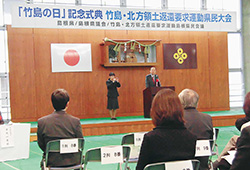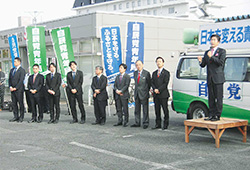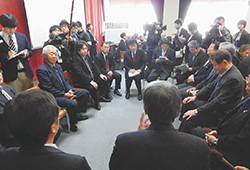This year marks the 63rd year of the Republic of Korea's illegal occupation of Takeshima (Okinoshima Town, Shimane Prefecture). The Prefecture, seeking an early establishment of territorial rights, passed an ordinance designating February 22 as "Takeshima Day," and on this day a commemorative ceremony was held in Matsue City attended by ten national legislators from the LDP representing both the Upper and Lower houses. Taimei Yamaguchi, Chairperson, Party Organization and Campaign Headquarters, told the gathering, "All of Japan will work together for the return of Takeshima, and the LDP will be in the forefront of the movement." The day also featured public speeches and an opportunity to meet with prefectural residents as legislators renewed their commitment to resolving the dispute as quickly as possible.
■ Commemorative ceremony

This year's 11th annual commemorative ceremony attracted 460 participants. Representing the organizers, Governor Zenbe Mizoguchi noted that Japan and South Korea held a summit last November for the first time in roughly three and a half years, and said, "We strongly encourage the continued discussion on the Takeshima issue during diplomatic negotiations."
Parliamentary Secretary of the Cabinet Office Yasuyuki Sakai responded by saying, "This is an important question that impinges upon Japanese sovereignty. We will do everything possible to reach a reasonable and peaceful solution in accordance with the law, and we will continue to tenaciously make Japan's case."
Representing the Party, Chairperson Yamaguchi had sharp words, saying, "It is difficult to repress our outrage at the unilateral establishment of the Syngman Rhee Line and the ongoing illegal occupation of Takeshima." He went on to call for the referral of the case to the International Court of Justice, something South Korea continues to reject, saying, "There is only one history. Since the past war, Japan has been tolerant of the many historical views asserted by South Korea, but this is something that we cannot ignore."
Mr. Yamaguchi had high praise for the Abe government, noting that it established a new position of the Minister in charge of Territorial Issues and a new "Office of Policy Planning and Coordination on Territory and Sovereignty" (Cabinet Secretariat) immediately after the formation of the second cabinet, and has also been active in dealing with Takeshima and other territorial issues, for example, by expanding textbook descriptions as recommended by the Party, and by improving Japan's communication of information both to its people and to the international community. " Japan as a whole must join hands to seek the return of Takeshima, and I vow that the LDP will stand at the head of a concerted movement to do so," he said.
■ Public speeches

As is customary, the Party held public speeches after the ceremony. In addition to Mr. Yamaguchi, the meeting also heard from Director Hideki Makihara, Deputy Director Akimasa Ishikawa and Deputy Director Hideki Murai of the Party's Youth Division; Chairperson Kosei Nagaya (Gifu Prefectural Legislature), Vice Chairperson Takumi Tamura (Saitama Prefectural Legislature) and Member Masahide Moroi of the Division's Central Standing Committee; and local Diet members Kazuhiko Aoki and Saburo Shimada, representing the Upper House.
Director Makihara spoke to a crowd of 300 who had gathered in the chilly weather, and emphasized, "The return of Takeshima is the return of the Japanese soul, and it is crucial that the ruling party establish a solid base of governance if we are to accomplish that." Chairperson Nagaya advocated continued efforts to spread "accurate maps of Japan" (produced by the Division) that indicate the entire territory of the country.
■ Citizens Conference

This year, for the first time ever, a "Citizens Conference on Takeshima Issues" was held prior to the ceremony.
The conference was organized by the "Federation of Prefectural Legislators for the Establishment of Territorial Rights over Takeshima" (Chairperson: Shigemitsu Hara) to promote discussion of the issues within Japan, and it featured the participation of 120 national legislators, prefectural residents and experts. In attendance from the Party were three members of the House of Representatives: Yoshitaka Shindo, Takashi Nagao, and Kenji Yamada, and three members of the House of Councillors: Masaaki Akaike, Kazuhiko Aoki and Saburo Shimada.
The conference was divided into eight groups, which heard many statements about the need for the government to take the lead in forming public opinion on the issues: "There is too little awareness of Takeshima; textbooks need to be improved;" "We should install models of Takeshima around the country to make the problem more visible;" and "I'd like to see a headquarters established within the government to deal with this, as is for the Northern Territories."
Representatives of the local fishing industry explained that the Agreement between Japan and the Republic of Korea concerning Fisheries that took effect in 1999 designated the waters around Takeshima as "provisional territorial waters" for the joint use of both countries, but Japanese fishing ships were in fact barred from the area. "The return of Takeshima is important, but even before that, we want to be able to jointly fish there," they said. Legislators from the Party listened intently to their appeal, noting that the issues were serious and extend far beyond illegal occupation.










